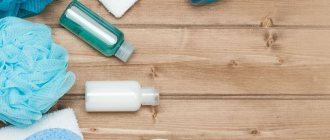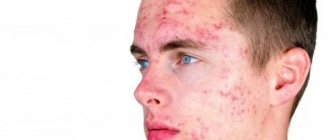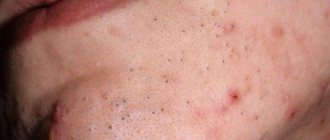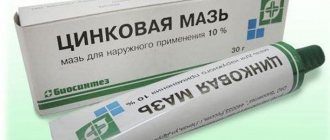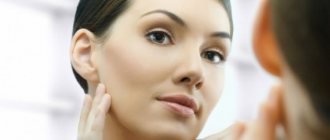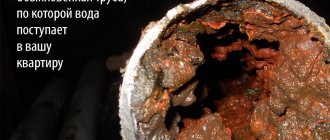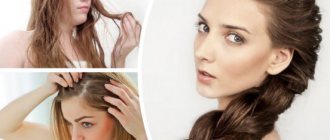- Rosacea: causes of appearance
- How to recognize rosacea on the face
- Main symptoms of rosacea
- Pink acne on the face: treatment
- Preventive methods of treating rosacea with folk remedies
Rosacea is a skin disease that most often occurs on the face and can be classified as either acne or dermatosis. Accompanied by symptoms of small pink nodules, which is different from the darker red acne. Later, due to lack of proper treatment, rosacea. can move to the next stage of development with the appearance of small purulent discharge on the head of the acne. Also, a distinctive feature of such inflammation is the expansion of the blood capillaries at the sites where rosacea appears.
Rosacea: causes of appearance
For quite long periods of time in the last century, many doctors and specialists associated the appearance of rosacea with frequent consumption of strong alcoholic beverages. Partly, this reason is true, however, what about the majority of people who cannot describe themselves as a heavy drinker? Research conducted at the end of the 20s and the beginning of the 21st century were able to provide the medical community with a more extensive list of the most likely causes of the appearance of pink acne on the body and face.
The first and, perhaps, the most common reason for their appearance is a problem with the blood capillaries under the walls of the skin. The essence of the problem lies in the too sensitive reaction of the capillaries to external stimuli, presented in the form of very spicy or hot food, long exposure to frost exceeding - 20 degrees, exposure to more 5 hours a day in heat above +30 degrees and the influence of ultraviolet radiation from the sun, the influence of fatty cosmetics or the consumption of alcohol, as well as taking certain types of hormonal contraceptives.
The second no less common group of problems and causes that cause rosacea on the skin are problems associated with the gastrointestinal tract, which has a far from indirect effect on skin problems.
Naturally, the cause of the appearance of pink acne on the face can be influenced by problems associated with the nervous system, which are closely related to the capillaries under the skin, problems due to the functioning of blood vessels clogged with cholesterol.
It is worth noting that often, if one of the listed problems is present in a person’s body, red acne may not appear on the skin, however, with a complex of two or more causes and main factors, the appearance of this kind of acne on the skin is quite likely.
The main area of distribution of rosacea is still the face, and especially the areas of the nose, cheeks, chin and forehead. More rarely, such pimples are found on unusual areas of the back or shoulders.
Also, a significant reason for the appearance of such acne is genetics, for example, this type of rosacea does not naturally occur in representatives of the dark race, while in whites or Asians the transmission of rosacea may be due to a hereditary factor in the tendency of the facial skin to such inflammations.
Acne in newborns
It is not uncommon for various redness and rashes to appear on the baby’s skin. This phenomenon can be associated with many reasons, but doctors specifically highlight rosacea in newborns, which mainly affects the cheeks, forehead and chin. How to treat rosacea on the face?
A photo example of what the disease may look like in a newborn is below in the article.
The development of this disease may have several explanations:
- Formation of the baby’s hormonal background - as soon as the hormonal changes are over, rosacea goes away on its own.
- Blocked sebaceous glands often cause breakouts. There is no need to worry or worry; this phenomenon goes away on its own over time. The main thing is not to squeeze out the resulting blackheads.
- Excessive humidity causes the so-called prickly heat. In order to get rid of it, you must not wrap your baby up to prevent overheating and sweating. It is recommended to treat the affected areas with infusion of calendula or chamomile. A shared bath with herbal infusion also works well against unwanted rashes.
- Allergies are a fairly common phenomenon among infants lately. The reaction can be to anything: food, household chemicals, synthetic fabrics. The treatment of such manifestations should be carried out by an experienced doctor; in no case should self-medication be allowed.
- A toxic reaction is a rash similar to mosquito bites that affects the baby’s back. Arises as a reaction to the environment.
Let's summarize. Rosacea, or rosacea, is a rather serious disease with dangerous complications. It is very important to recognize it at an early stage and promptly consult a doctor for treatment.
Rosacea or rosacea is a chronic inflammatory skin disease characterized by persistent redness of the face and the appearance of rashes. Unlike acne, rosacea does not cause comedones - black or white dots on the surface of the skin.
How to recognize rosacea on the face
Poll: When did your acne appear? (Number of votes: 4295)
I've been suffering all my life
It's been a couple of years now
About a few months
Recently
To vote, click on the desired answer. results
Of course, the best option for determining the type of acne and finding out the method of treating it is to diagnose and make a diagnosis by the attending dermatologist. Diagnosis can only be done by an external examination of the structure of the inflammation itself, and it may also be necessary to undergo a certain group of tests, including blood and urine tests, as well as microscopic analysis of a small piece of skin.
At home, you can identify rosacea by its light pink color, as well as the fact that these types of acne take much longer to heal than pimples. In these types of inflammation, there is more pronounced swelling. In the later stages of maturation of these forms of acne, there may be a purulent discharge similar to for purulent acne.
If treated incorrectly or not, more severe forms of skin diseases can occur with large redness on the face Rosacea can even touch the eyes, as a result of which the eye capillaries burst and pink inflammation appears in the areas around the eyes Therefore, if the treatment process for rosacea is not started in time, Unfortunately, such a disease can lead to more serious inflammation and the development of skin infections.
How to easily and quickly cover up acne without makeup!
Why does it appear
Scientists have not determined the exact cause of the disease. It usually affects women over 30 years of age with blond hair, blue eyes, and light, delicate skin. The genetic factor plays a role: about half of all patients had the same diagnosis in their family. Many doctors reject the hereditary factor.
Solar radiation has not proven its right to exist: representatives of Asian and African peoples are almost unfamiliar with rosacea, although they are subject to increased solarization.
The disease does not bypass men either. Their disease develops more rapidly.
Previously, it was believed that acne was caused by alcoholic beverages, but the theory was not confirmed. Alcohol becomes a provoking factor, but not in all cases.
Doctors discovered a connection between the disease and the trigeminal nerve; a small area is associated with small vessels in the cheeks and nose. The capillaries in this area of the face become sensitive to external irritants: spicy, hot, cold, heat, alcohol. Under the influence of irritants, the capillaries expand, but do not have time to narrow. This is what causes pink or red skin.
Demodex mites were also considered to be the cause of the disease. These mites live on the surface of the skin of 90% of the world's population. In some cases, demodicosis therapy is effective for rosacea.
Rosacea appears under the influence of internal problems in the body:
- the bacterium Helicobacter pylory, which settles in the stomach, causes gastritis, ulcers, and dysfunction of the gastrointestinal tract;
- endocrine disorders, hormonal imbalance;
- nervous diseases, although some studies show that nervous disorders develop as a result of the disease: patients with rosacea have emotional instability and depressed mood;
- angiopathy, fragile blood vessels, poor circulation;
- some medications: steroids, corticosteroids in medications and cosmetics.
Factors cause disruption of cell metabolism and insufficient oxygen supply. The tone of facial vessels decreases, the reaction to stimuli is impaired.
Main symptoms of rosacea
In the first stage, small, inflamed pink rashes develop, most often on the nose, cheeks, chin or forehead.
In the second stage of the disease, small purulent inflammations often appear on the head of the acne.
During the third and last stage of the formation of the rosacea disease, as a result of the prolonged action of vasodilation, a process of formation of a network of burst capillaries occurs, which is reflected on the facial skin in the form of a long line of redness and large inflammations of rosacea. At this stage, aggravation around the eyes and a feeling of dryness in the eyes are also possible .
Rosacea photo
Treating acne at home
In combination with traditional methods of therapy, they can be treated using folk recipes. Decoctions of medicinal herbs relieve redness and inflammation. To prepare them, use chamomile, sage, rose hips, St. John's wort or calendula flowers. The plants are brewed with boiling water and infused for 8 hours, then filtered. A piece of gauze is moistened in the cooled product and applied to the face.
You should not squeeze out acne on your own; infection may occur, which will lead to increased inflammation and swelling. It is also contraindicated to wash your face with hot water; heat promotes the active growth of bacteria. Essential oils are not suitable; they leave a greasy film on the face, which clogs the ducts of the sebaceous glands and leads to the development of purulent processes. It is forbidden to treat rosacea with iodine, as this will cause the formation of subcutaneous abscesses.
An effective folk remedy for acne is an aqueous solution of propolis; you can buy it at the pharmacy or prepare it yourself. It is used to wipe the face before going to bed; in the morning you need to wash it with soap. This product is also useful for strengthening the immune system when consumed orally.
Treatment at home is performed using a face mask. It is made from natural honey and aloe vera juice. The mass is placed on a cotton cloth and applied to the affected areas for 20 minutes, then washed with cold water. The folk remedy reduces inflammation and irritation, acne matures faster, and tissue heals. The mask needs to be done once every 2 days, a total of 10–20 sessions may be needed. The procedure is contraindicated for people who are allergic to bee products.
Freshly squeezed cranberry juice treats rosacea; it is used as a cold lotion. The berries contain vitamins B, C, nicotinic acid and beneficial microelements. Apply a compress to the face every day until acute symptoms subside, then it can be applied every other day and gradually increase the intervals until the skin condition normalizes. The unique composition of cranberries helps normalize the pH of the epidermis, metabolic processes, get rid of acne, strengthen capillaries and local immunity.
Prevention of rosacea
To reduce the number of relapses and prevent rashes, the following rules must be followed:
- use cream with UV protection;
- avoid prolonged hypothermia;
- exclude active sports;
- use cosmetics that do not irritate the skin of the face;
- create a balanced menu;
- promptly treat concomitant diseases;
- protect your face from direct exposure to sunlight;
- you cannot visit the sauna, solarium, or take a bath that is too hot;
- give up bad habits and lead a healthy lifestyle.
Compliance with preventive measures significantly reduces the risk of developing exacerbations and acne. Signs of the disease appear less pronounced, purulent inflammation and tissue scarring do not occur. Patients with a diagnosed disease and people at risk should adhere to the recommendations.
Rosacea is a serious disease characterized by damage to the facial skin and the appearance of inflamed acne. The pathology has a progressive course, symptoms gradually intensify, and complications develop. Treatment is prescribed by a dermatologist, taking into account the causes of the disease. To obtain the best result, it is useful to combine traditional methods of therapy and folk methods.
Pink acne on the face: treatment
The problem with treating pink acne on the face is that using even the most effective and reliable treatment methods without proper diagnosis and an individually selected course of treatment by the attending physician - a dermatologist - can lead to adverse skin reactions and new foci and stages of inflammation.
The second problem in the treatment of rosacea is that after diagnosing the problem of their appearance, in addition to getting rid of the external inflammation of rosacea, you also need to resort to a complex treatment of internal problems associated, for example, with dilated blood vessels, nerves and other problems in the body that you can determine. They are simply not competent to cure it on their own.
Treatment of rosacea is carried out by treating both external and internal causes of its occurrence by taking medications by mouth, including antibiotics, or applying creams or ointments for external use as prescribed by the attending physician.
The duration of the course of treatment for rosacea and acne depends primarily on at what stage of development you see a doctor. Of course, with an early stage of the disease you will need less than a month, while at a later stage it may take from 2 months to half a year.
The main means for external treatment of rosacea are creams and ointments, the main active component of which is metronidazole. At the end of the course of treatment, to completely get rid of rosacea, a cosmetic method can be used to remove large blackheads or the consequences of their presence on the skin by removing them with a laser.
Causes
Today it is not known exactly for what reasons rosacea develops. Doctors identify internal and external factors, including:
- frequent exposure to the sun, exposure to chemical or physical negative factors on the skin;
- use of hormonal medications;
- lack of vitamins;
- presence of bad habits;
- various gastrointestinal diseases;
- tick infestation;
- pathologies of the endocrine system, etc.
If rosacea develops, the causes must be looked for carefully, since people face many risk factors, but the disease is still not detected in everyone.
Preventive methods of treating rosacea with folk remedies
A fairly large number of folk recipes can indirectly or directly help us get rid of rosacea and acne, or help you prevent the process of inflammation and the development of rosacea infection:
- One such remedy is calendula tincture, which must be applied by dipping a gauze bandage into it and applying it to the face.
- You can also use yarrow tincture for a large number of acne on your face. To prepare it, you just need to pour boiling water over two tablespoons of its herb, and then wait for the natural medicine to infuse for half an hour.
- White cabbage juice, which is also applied to the skin by applying a gauze bandage to the face, will help you reduce inflammation and remove ulcers on acne.
- A tincture of nettle leaves will help you especially effectively against rosacea, which should be prepared in the proportions of 2 nettle leaves per 200 ml of water. The product should infuse for at least two hours.
How is the disease treated?
It is impossible to completely get rid of acne, but modern medicine can keep it in remission. Rosacea therapy is complex: external treatment is carried out using antimicrobial agents: creams, ointments.
If external remedies do not help get rid of pink acne, then antibiotics and antiparasitic agents are prescribed.
- tetracycline antibiotics for the treatment of pathogenic microbes in acne with purulent contents.
Minolexin is a modern anti-inflammatory drug from the tetracycline group. The effect is fast and lasting. There are few side effects.
- ointments with Metronidazole, in the presence of parasites, are used in conjunction with tablets;
- Isotretinoin is prescribed in severe cases; it is a synthetic analogue of vitamin A;
- Ointments – Rubirol, Tretinoin, Metrorubirol;
- Ointment with azelaic acid Skinoren smoothes the skin, heals, and prevents the appearance of new acne.
To strengthen the walls of blood vessels, take vitamins A, B, C and nicotinic acid.
Do not use ointments with corticosteroids: they eliminate acne, but after a few weeks the rosacea returns.
Laser is used to eliminate skin defects:
- eliminates the consequences of the disease;
- restores and improves metabolic processes;
- eliminates existing pustules and papules;
- Laser resurfacing restores skin smoothness.
Several more methods of treating and cleansing the skin:
Ozone therapy is the removal of inflammation using subcutaneous or intravenous administration of ozone together with saline solution.
Dermabrasion – peeling, cleansing, removal of acne scars.
Phototherapy – exposure of affected areas of the face to bright light. Eliminates enlarged pores, wrinkles, age spots.
Electrocoagulation – elimination of skin imperfections using an electrocoagulator.
Cryotherapy is the treatment of skin with liquid nitrogen.
External skin treatment will not provide long-term results. You should visit a gastroenterologist, endocrinologist, neurologist, immunologist, for in-depth diagnostics to identify internal diseases.

